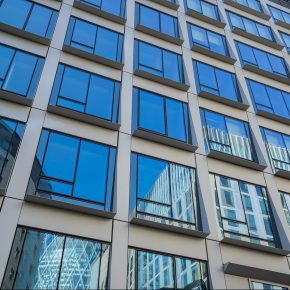
GUEST ARTICLE: How councils can utilise unused office space
With councils currently coming under financial strain and cutting services, solutions that can be offered to help them save money and cost efficiently deliver their essential services are welcome, writes Saghir Hussain, CEO of Create it Studio Architects, in this guest article…
According to Inside Government, 41% of public sector workers are now working remotely and further evidence from ONES suggests that on average 40% of desks are vacant.
Many councils up and down the country have been forced to cut services as the current financial uncertainties in the UK continue, leaving councillors in the difficult position of deciding what their jurisdictions can do without. Warrington Council is a recent example of a council making strategic cuts without negatively affecting its people by managing to save £750k from a bill of £23 million. They did this by moving offices.

Moving offices or going completely remote can be cost effective but with 83% of people preferring a hybrid working model this can create its own difficulties; a process of redesigning the current office space, offering the space to the public and rethinking the layout of working spaces, can give councils the benefit they seek to bolster the efficiency of their space.
Through hotdesking solutions it is believed that councils can reduce operating costs by up to 30%. They can also reduce space by up to 25%. However, in order to make the most of this opportunity there needs to be a solution with what can be done with that space:
Tiered Approach
With the implementation of a tiered approach within the office space of the building, there is the potential for accommodating a wider diversity of user preferences and requirements. Upper floors provide more private offices to cater to larger businesses that need self containment and confidentiality, offering quiet environments for client meetings and more focused work. Lower floors with open plan common areas and shared amenities will cater to start-up organisations as well as freelancer and smaller businesses seeking a collaborative environment that reduces their expenditure.
Open Plan Areas with Amenities
Open plan areas integrated with libraries and café services can foster collaboration, creativity and interaction with the community. They hold the potential to serve as hubs for networking, informal meetings and the sharing of knowledge and ideas among users from different tiers. With the added presence of amenities enhancing the appeal of the office space, it becomes a more attractive destination for both visitors and tenants.
Support for Small Businesses
Providing support for smaller businesses, such as flexible lease terms or reduced business rates will encourage entrepreneurship and foster economic growth. With affordable office space and the availability of amenities, the building can become the foundation and launchpad of start-ups. With the inclusion of networking spaces, these small businesses are further empowered to grow and contribute back into the community.
Council Office Integration
There is further opportunity for cost effectiveness with the inclusion of self-contained spaces for council offices within the building, ensuring that essential administrative services are available while promoting the interaction between government and citizens. The strategic location of the council offices on designated floors will offer convenience and accessibility to businesses and residents.
By co-locating council offices with other tenants a connection between the two is created and resources optimised to save costs, benefitting both the public and private sector businesses.
The advantages of redesigning council offices to allow for co-working spaces are endless. This is especially true in towns that have seen a decline due to their proximity to major hubs. Bolton, Wigan, and Rochdale are great examples of towns that have seen a decline in economic output as people commute to Manchester.
While currently there is no policy in the UK around coworking spaces there is significant evidence, according to Business Reporter, that other countries such as Italy and Ireland have already started working on this to help develop rural areas or areas that are in need of ‘levelling up’.
Latest news

30th April 2025
Digital Construction Week announces seminar programme for its landmark 10th edition
Digital Construction Week (DCW) returns to ExCeL London on 4 – 5 June 2025 with its most impactful programme yet. It brings together the best and brightest from across AECO, for two days of practical learning and idea sharing.
Posted in Articles, Building Industry Events, Building Industry News, Building Products & Structures, Building Services, Building Systems, Exhibitions and Conferences, Information Technology, news, Restoration & Refurbishment, Retrofit & Renovation, Seminars
29th April 2025
Senior pledges to ‘bee’ part of the solution with new biodiversity initiative
Senior Architectural Systems has installed its first on-site beehive, marking another step forward in its commitment to sustainability and biodiversity.
Posted in Articles, Building Industry News, Building Products & Structures, Building Services, Curtain Walling, Doors, Glass, Glazing, Innovations & New Products, news, Restoration & Refurbishment, Retrofit & Renovation, Sustainability & Energy Efficiency, Walls, Windows
29th April 2025
West Fraser range delivering key benefits for South-East carpentry company
An experienced carpenter and building site manager who has recently set up his own company is using high performance panel products from the West Fraser range.
Posted in Articles, Building Industry News, Building Products & Structures, Building Systems, Case Studies, Garden, Restoration & Refurbishment, Retrofit & Renovation, Sustainability & Energy Efficiency, Timber Buildings and Timber Products
29th April 2025
CPD Courses Available Online From Ecological Building Systems
Ecological Building Systems, a leading supplier of natural building products for sustainable construction, has revealed its comprehensive CPD programme for the year ahead.
Posted in Articles, Building Industry Events, Building Industry News, Building Products & Structures, Building Services, Continuing Professional Development (CPD's), Information Technology, Innovations & New Products, Insulation, Restoration & Refurbishment, Retrofit & Renovation, Seminars, Sustainability & Energy Efficiency, Training, Walls, Waste Management & Recycling
 Sign up:
Sign up: